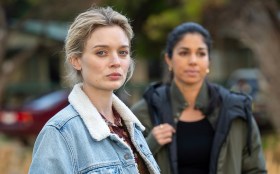Image: threatened by broadcaster Bottersnikes, the Gumbles are fighting back. The series was made by Cheeky Little Media for Seven, with the BBC and Netflix as international partners.
Seemingly from nowhere, a great messy pulse of anxiety has burst out over the state of children’s television in Australia. Yesterday Sarah Hanson-Young committed the Greens to defending kids’ TV with a petition to bolster some action in the Senate.
If you need to be convinced that local kids’ TV should be supported, watch Little J and Big Cuz on NITV or SBS catchup. It launched just 24 hours after the Greens’ petition.
SBS has already turned the production story into a support piece for the campaign.
The Conversation came out with a general article which covers the slow decline of the sector in Australia as animation takes over and live action gets even harder to fund. Jenny Buckland, CEO of the Australian Children’s Television Foundation, has been sounding the alarm about this in public for years.
Screen Producers Australia has been defending the content standards to all the political players and is determined to remain apolitical, like any lobbyist defending a long-term position. Trudging around Parliament, it discovered Sarah Hanson-Young, the Greens Senator and representative on youth and the arts, and the parent of a ten year old child herself, who responded to the issue. As she is quoted in her announcement, ‘The Greens will be moving in the Senate to support children’s television in Australia and strengthen the requirements for our broadcasters.’
So, the Greens published that petition to the Senate calling on Minister Fifield: ‘Minister, please don’t let Australian children’s television die.’
A successful petition will help to demonstrate to a wedged government that this is an explosive issue, particularly for the families all politicians love to valorise. It will be a useful tool in the Senate to embarrass the government, and maybe even force some kind of position. Unfortunately the government does not have to bring any regulatory change to the Senate so it can’t be fought in the upper house, unlike almost everything else.
The petition has a thousand signatures in the first day, which is considered to be a very positive number. Screen Producers Australia added its own voice. ‘We want Australian stories on Australian screens. We want Australian children dreaming Australian dreams. We can’t sleepwalk into a nightmare situation where no Australian children’s content gets produced and our children don’t see themselves reflected our screens.’ said CEO Matthew Deaner.
‘Removing these obligations on commercial broadcasters, together with any withdrawal of support from the public broadcasters, will mean Australian children’s content just won’t get made.’
Make no mistake, the children’s sector is an important part of the industry. The figures bounce around a lot, but last year saw fourteen kids’ shows made for a total budget of $101m, adding up to 115 hours. Of that $66m was the actual spend, reflecting the role of co-productions. The amount was $10m up on the five year average. However, the number of co-productions is slipping.
The total spend on adult Australian TV drama for 2015-16 was $376 million. So childrens’ represents about a sixth of the whole sector in real terms, but that money is concentrated outside the largest companies to sustain a robust group of true indies. What is more, the work is concentrated in the animation sector, again amongst smaller independent creatives. Bottersnike and Gumble for instance is fabulous, animated by Mighty Nice in Sydney.
Read more: Cheeky Little Media raising the ambient temperature of kids’ animation.
According to the Screen Australia drama report for last year, ‘In 2015/16, children’s TV drama programs made for the ABC accounted for the largest share of both hours and expenditure, while the Seven Network had the largest share of total budgets….
‘… In the last financial year, the Seven Network provided production finance to 26 hours (two titles), consistent with last year and similar to its activity in previous years. The Nine Network financed 28 hours (three titles), an increase from 12 hours for two titles last year. Network Ten financed 26 hours (two titles) a slight decrease from last year’s 34 hours for three titles.
The involvement of the commercial networks is worth far more than their own investment. To secure the 20% rebate, and any additional Screen Australia investment, companies must also have a local broadcaster. Companies need their signature to secure overseas sales and – most important – overseas coproductions. They become the gatekeepers, obsessed with local issues, for the sector’s ability to earn overseas revenue. That is a pretty incendiary problem.
Two simple conclusions: the commercial networks are a fundamental part of the mix, and the sector really, really needs the revenue, creativity, overseas income and scale of children’s companies.
However, the raw productions numbers are actually encouraging, which cuts across the doom and gloom. Why is the industry talking crisis?
Children’s producers have been watching the international market for co-pros decline since the Global Financial Crisis, which morphed horribly into the loss of young audiences on broadcast TV, which led in turn to an evaporation of advertising revenue.
Meanwhile, the industry has continued to fend off the commercial TV provider’s visceral hatred of the quota system. They are required to broadcast 260 hours of C or children’s programming per year, with at least 25 hours per year to be first release Australian programs, with a total of 96 hours over three years. They argued their deregulation case to the Convergence Review of 2011, which ruled that the adult drama sector would survive the loss of quotas but the children’s sector would not.
Beyond emotion, they are driven by the fact that they can’t sell advertising on those slots. With low audiences they are not worth anything like enough to sponsors, and the kind of advertising is regulated anyway. The Australian Association of National Advertisers administers a self-regulation system by which commercial broadcasters force themselves to be noble and cripple their own revenue streams in food and beverages. All they see is loss, loss and more loss, stretching all the way to a bureaucrat’s polished shoes.
They have never stopped campaigning. Through last year, we kept running into rumours that the ACMA was to run an enquiry into the content regulation system, but it has never quite materialised. That would be a major escalation, allowing the commercial broadcasters the best possible platform.
Senator Hanson-Young has taken to asking Minister Fifield in Senate Estimates whether the government has any plans to change the system and he has never given a straight answer.
The latest version of this cropped up at the The House of Representatives Enquiry into Factors contributing to the growth and sustainability of the Australian film and television industry, (often assumed to come from the Senate), which has received submissions and is deliberating on the outcomes. Run entirely by backbenchers far away from political power, it looked like a sideshow, but has turned out to be the right soapbox at the right time.
Read more: Government enquiry puts independent production in the hot seat.
The submissions from SPAA, ACTF and other heavy hitters like Village Roadshow are online, creating a web of mutual support. But the national broadcasters, Free TV Australia, and the regional broadcasters have all made submissions which are currently languishing in a parliamentary office, shunted aside until Parliament returns. The submission made by Free TV Australia, its lobbying body, has circulated pretty widely and been reported.
It is very explicit. Here is Seven, as quoted by The Australian – ‘Such a highly interventionist regulatory requirement needs be examined and serious consideration given to whether there is sufficient justification for the ongoing imposition of a children’s television quota…. In our view the time is right to move on from the overly interventionist model of children’s television quotas and they should be abolished.’
While most political attention will be on the May 9 budget, The Australian Communications and Media Authority is having what it calls an Australian Content Conversation on May 16-17 in Sydney – ‘In conjunction with the Department of Communications and the Arts and Screen Australia, we’ll explore themes including the importance of Australian content, the diversity of local voices and the regulatory challenges and opportunities in a world where citizens expect access to the content they want, when and where they want it run.’
Deregulation will be in the air, and there is some speculation that Minister Fifield will announce that enquiry into Australian content regulations. But Jenny Buckland, throught the ACTF a careful student of regulatory politics, says, ‘It seems to be considered as a separate exercise. And I have to say it is extremely disappointing that 45 minutes have been allocated to discuss children’s TV. I think it is actually one of the bigger discussions to have.’
Now the tension has been racked up dramatically by the nightmare at Ten. On April 27, it reported a $250m half yearly loss. $214m of that comes from writing down the value of its license, but costs went up by $20m, while a revenue increase of $7m took the income to $341m, while total capital city advertising declined 5.6%
Ten has a particular problem with its finances as it needs to convert a current $200m loan facility into $250m by the end of the year, and pay off one provider while finding another. If not, the company could be broken up to pay the bank along with Lachlan Murdoch, James Packer and Bruce Gordon. With shares at 36c, the whole shebang is valued at $133m.
However, it allows everyone on the commercial TV side to threaten the government with the spectre of an exploding channel if it doesn’t drop license fees, deal with those pesky quotas, and deregulate media sales so Ten could be bought at maximum value.
All by itself, the crisis dramatises the sheer frustration of the players as nothing has been done ever since the Convergence Review.
However, the commercial television proprietors are not the only ogres under the children’s TV bed. While Seven argues that audiences are so bad because they have all drifted to the ABC, the sector has believed for some time that the government broadcaster has been shifting expenditure away from children’s TV. Auntie always makes soothing noises about the difficulties about assigning expenditure to particular years and digital change and blah blah its all cheaper now, but it hardly sounds convincing.
As Buckland says, ‘The ABC doesn’t have any charter obligations to do children’s and has no content guidelines for Australian drama so we can see what they are doing.’
In the last financial year, Screen Australia invested in six productions costing $44.1m for a total of $8.6m. They were central to the high budget productions – of the other eight that year some would be commissions by commercial broadcasters which did not pay a minimum license fee of $100,000/hour. Now Screen Australia is struggling to deal with government cuts, and no part of the industry is safe.
If the commercial channels are allowed to step away from the arena, the government investors will be under increased pressure to provide a solution. And they can’t.
According to Buckland, the projected losses would lead to a tiny industry. ‘There would be a couple of programs a year by the ABC and that would be it. And there is a problem created by the Free Trade Agreement [with the US]. If we take those quotas away, we can’t reinstate them.’
But she also acknowledges that the system is anachronistic. Audiences are declining across the FTA board as kids go online, or drift to Foxtel or go even further to Netflix. But, she believes, we are entitled to have a solution before we contemplate change. Besides, there is probably little appetite in the government to be seen to be stealing Australian toys from Australian babies, so Fifield is waiting for the sector to find a collective solution.
In talking to SPA, the ACTF and the Greens, one new(ish) motif has emerged. Regulating Netflix and Amazon Prime is on the agenda. The word around Hanson-Young’s office is that Brazil is now doing exactly that. And I am left to wonder if that option is part of their interest in the issue. Certainly the Netflix problem is in their statements.
There is a paradox for commercial TV. They would love to see the regulators thrown off a cliff, but they would also love to see them going to work on the international SVOD providers. It won’t be self-regulation.
—–
Bloomberg has covered the rise and rise of Netflix in Brazil; there is no reference to regulation but it does show why the company would accept a little friction.
The Screen Australia paper Child’s Play: issues in Australian children’s television, published in 2013, covers the issues in more detail and includes a sidebar on the woes of UK production:
The Broadcasting Act 2003 removed the requirement for commercial channels FIVE and ITV to carry children’s programs. In 2006 a ban on the advertisement of foods high in fat, sugar and salt during children’s programs was introduced. (While there are certain restrictions on advertising during children’s programs in Australia, these do not extend to an outright ban on advertising such food products.) After the ban, advertising revenue around children’s content dropped and commercial networks reduced or ceased commissioning children’s programs. Lower production levels combined with the growth of dedicated children’s channels has seen the proportion of first-release UK children’s programs fall to less than 1 per cent of all children’s programs broadcast in the UK in recent years..





